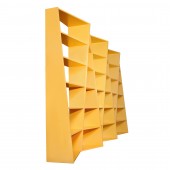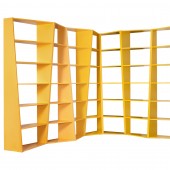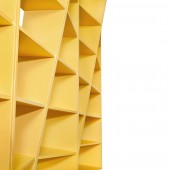
| THE AWARD |
| CATEGORIES |
| REGISTRATION |
| SUBMIT YOUR WORK |
| ENTRY INSTRUCTIONS |
| TERMS & CONDITIONS |
| PUBLICATIONS |
| DATES & FEES |
| METHODOLOGY |
| CONTACT |
| WINNERS |
| PRESS ROOM |
| GET INVOLVED |
| DESIGN PRIZE |
| DESIGN STORE |
| THE AWARD | JURY | CATEGORIES | REGISTRATION | PRESS | WINNERS | PUBLICATIONS | ENTRY INSTRUCTIONS |
Bibili Shelves System by Rosset Thierry Michel |
Home > Winners > Design #32980 >Interview |
 |
|
FS: What is the main principle, idea and inspiration behind your design?
TR: The basic idea was to expand our living space without moving walls. To be accomplished, the imagined subterfuge was to intervene on furniture: to design a shelf truncated with any non-existent part immediately retrieved mentally. The result provides the impression that space continues beyond the wall where the shelf stands.
FS: What has been your main focus in designing this work? Especially what did you want to achieve?
TR: To obtain the desired feeling it was necessary to obtain a dynamic and not an amorphous shelf. One triangulated upright shelf achieves dynamism, the other being not existing at first. The initial design was not convincing at all. By retaking and manipulating my wax sketches I noticed a surprising graphic line when two triangulated uprights were reversed. From there I did the 1:1 scale models and was very excited by the result. I failed in my original draft due to a line, the famous line I was always looking for, but ultimately it came to my rescue.
FS: What are your future plans for this award winning design?
TR: First of all I would like to express my great pleasure at having been awarded “A design award” as “bibili” is only my second design realisation. I have not yet consulted the contest statistics, but I imagine that the number of applications received was awesome. It is somewhat a feat to have been awarded and, of course, it is really very important because it underlines my ability to recognize a good design. This reward is also crucial for the rest of my design activity. Here, unlike the artistic field, we are speaking about a marketable product with a potential return on investment. This is especially critical when you start. Therefore I hope that through this distinction my design will find an economic materialization.
FS: How long did it take you to design this particular concept?
TR: Surprisingly little time. This was even more surprising because my previous realisation, the “ligne Guff”, took and still takes me a lot of time without reaching yet the level of my expectations. As the “bibili” doesn’t involve any technical difficulties, I was able to make the models myself in real size and so to quickly assess the results. This way we gain a lot of time. I was amazed by the speed of the inspiration process for this project. From a time perspective, the “bibili” was an ideal design.
FS: Why did you design this particular concept? Was this design commissioned or did you decide to pursuit an inspiration?
TR: As a beginner I have little chance to work on order. Therefore, inspiration guides my work. If by chance I get a future in design, I am not sure that I’ll be comfortable working on order even if it is certainly the best way to progress. The best way to know is to try. So if there are interested sponsors...welcome!
FS: Is your design being produced or used by another company, or do you plan to sell or lease the production rights or do you intent to produce your work yourself?
TR: I hope that this design will be manufactured. Even if this business world is a black box for me now, I am pretty sure that the “bibili” is the type of product, which should interest editors of furniture. Let’s check!
FS: What made you design this particular type of work?
TR: The “line”. While my first project failed, I discovered a graphic line that I found amazing and that convinced me to go ahead.
FS: Where there any other designs and/or designers that helped the influence the design of your work?
TR: Certainly not! At this point it becomes a cultural deficiency. Indeed, I consider that we turn, all of us, around the same topic. A chair is still a chair. I therefore prefer to remain untouched by any outside influence. My approach to take on the design more “artistically”, in the sculpture, fits me perfectly.
FS: Who is the target customer for his design?
TR: Everyone! And I am very happy because this contributes greatly to the intrinsic quality of a design product. Everyone, because the product should be sold at a very reasonable price and because it is adaptable to a maximum number of spatial configurations thanks to its high modularity. A single module provides already a great effect. In addition the whole effect is reinforced by its profile view. Therefore it can turn tight spaces such as corridor lanes into “design” spaces. It can also have a very effective effect in shops, which are often narrow and deep.
FS: What sets this design apart from other similar or resembling concepts?
TR: I would say that the « bibili » is specific by its very strong personality, its great modularity and the existence of corner modules.
FS: How did you come up with the name for this design? What does it mean?
TR: “bibili” is the name chosen by disappointment! Indeed, all other names I thought of were already used. But finally this name suits me perfectly. It comes from the French word “bibliothèque”. Commonly in French we summarize this word with “bibli” and as I like to play with words, I use quite often the word “bibili”. As this term didn’t seem to be already referenced, I choose it.
FS: Which design tools did you use when you were working on this project?
TR: Mainly wax, extruded sajex and a 3D drawing application.
FS: What is the most unique aspect of your design?
TR: To have managed to infuse the shelf with a personality and a quality of presence that I have rarely seen.
FS: Who did you collaborate with for this design? Did you work with people with technical / specialized skills?
TR: In addition to the company that provided me with the finished materials with the desired dimensions, I appealed to a friend carpenter for the mounting of the modules. He is a young enthusiastic, hard-worker, who has created his “Exotic Construction” company whose passion is the realisation of vivarium, aquarium and plant walls. I was very pleased with this new collaboration. He immediately became enthusiastic about the project, did not count his time and provided some materials for free. This attitude is just fantastic and necessary to initiate projects, whatever they are. I am particularly interested by this way of working and I expect to develop it in the future. Of course, in case of success the favour will be returned immediately!
FS: What is the role of technology in this particular design?
TR: Absolutely none. And I really like that. Indeed, I am particularly pleased with the result obtained somehow from simple boards.
FS: Is your design influenced by data or analytical research in any way? What kind of research did you conduct for making this design?
TR: No research or approach in that sense. This is not my style, at least not yet. I am only using my feeling.
FS: What are some of the challenges you faced during the design/realization of your concept?
TR: I was literally drowned in a 3D puzzle when assembling the shelves. All parts are identical but their sense of direction change depending on the model to be achieved. There were many pitfalls and I needed to disassemble and reassemble more than once. Even if they look very simple, the corner modules dimensions were also problematic to calculate. There are times where you feel really silly.
FS: How did you decide to submit your design to an international design competition?
TR: When creating a design product obviously we think about its distribution. The first idea that comes to mind is to look for furniture manufacturers. I was absolutely alarmed by the number of existing companies. How to select the right partner? How to be selected by one? An article published by a firm reported that its decision to work with a young designer was based on his ability to be regularly awarded for his designs. For me it is certainly the best way to be identified. On the other hand, there is no established nor recognized critique in design such as exists for movies. So, if I launch a product it is only on my own evaluation without any guarantee that it is a good product. Participating in competitions provides the useful feedback about your work. Having been awarded confirms my ability to select a good design project to invest time and money in.
FS: What did you learn or how did you improve yourself during the designing of this work?
TR: With the “bibili” I became closer to the designer profession in the sense that I integrated, from the beginning, some manufacturability constraints like the type of raw materials and the process. It was absolutely not the case with my previous realisation.
FS: Any other things you would like to cover that have not been covered in these questions?
TR: No.
FS: Thank you for providing us with this opportunity to interview you.
A' Design Award and Competitions grants rights to press members and bloggers to use parts of this interview. This interview is provided as it is; DesignPRWire and A' Design Award and Competitions cannot be held responsible for the answers given by participating designers.
| SOCIAL |
| + Add to Likes / Favorites | Send to My Email | Comment | View Press-Release | Translations |





